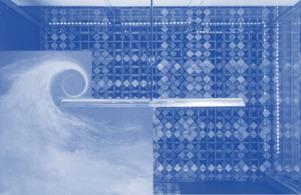自由流湍流对翼尖涡曲流和变形的影响
IF 2.6
3区 工程技术
Q2 ENGINEERING, MECHANICAL
International Journal of Heat and Fluid Flow
Pub Date : 2025-09-08
DOI:10.1016/j.ijheatfluidflow.2025.110013
引用次数: 0
摘要
在基于弦的雷诺数为105的条件下,研究了自由流湍流对翼尖涡的影响。实验分别在0.30%、1.84%、7.70%和13.25%的主动网格产生的4种FST强度下进行,积分尺度为0.5 ~ 2.6倍翼弦长。三维粒子图像测速测量记录了FST对NACA0012机翼近场和中场(即机翼后缘下游x/c=[2,5,12]平面)翼尖涡蜿蜒运动的影响。为了消除涡旋运动的影响,采用了基于坐标系在涡旋中心重新定心的条件平均方法。当对涡旋核心位置进行有条件平均分析时,观察到涡旋强度随着FST的增加而降低,同时在FST最高的情况下(FST水平>;6%)扩散略有增加。对顺流涡度场相干分量的快照正交分解(POD)分析揭示了所有FST情况下与弯曲位移相关的两种主要模式。POD分析进一步表明,湍流加速了与旋涡变形相关的空间模式的发生,在非湍流条件下通常出现在远尾流(x/c≥36),而在FST存在时出现在近尾流(x/c=5)。在非湍流条件下,近尾迹湍流情况下涡变形模式对总熵的贡献比远尾迹更显著。本文章由计算机程序翻译,如有差异,请以英文原文为准。

The effect of freestream turbulence on wing-tip vortex meandering and deformation
The effect of freestream turbulence (FST) on a wing-tip vortex was investigated at a chord-based Reynolds number of . Experiments were conducted at four FST intensities, generated by an active grid, 0.30%, 1.84%, 7.70%, and 13.25%, with integral scales ranging from 0.5 to 2.6 times the wing chord length. Stereoscopic particle image velocimetry measurements document the effects of FST on the meandering motion of the wing-tip vortex in the near field and middle field of a NACA0012 wing, i.e., planes downstream from the trailing edge of the wing. Conditional averaging based on recentring the coordinate system on the vortex center has been used to eliminate the influence of vortex motion. When the analysis was conditionally averaged on the vortex’s core position, a reduction in vortex strength with increasing FST was observed, along with a slight increase in diffusion for the highest FST cases (FST levels ). Snapshot proper orthogonal decomposition (POD) analysis on the coherent component of the streamwise vorticity field revealed two dominant modes associated with meandering displacement for all FST cases. POD analysis further reveals turbulence accelerates the onset of spatial modes associated with vortex deformation, which typically emerge in the far wake () under non-turbulent conditions but appear in the near wake () when FST is present. The vortex deformation modes contribute more significantly to the total enstrophy in turbulent cases in the near wake than in the far wake under non-turbulent conditions.
求助全文
通过发布文献求助,成功后即可免费获取论文全文。
去求助
来源期刊

International Journal of Heat and Fluid Flow
工程技术-工程:机械
CiteScore
5.00
自引率
7.70%
发文量
131
审稿时长
33 days
期刊介绍:
The International Journal of Heat and Fluid Flow welcomes high-quality original contributions on experimental, computational, and physical aspects of convective heat transfer and fluid dynamics relevant to engineering or the environment, including multiphase and microscale flows.
Papers reporting the application of these disciplines to design and development, with emphasis on new technological fields, are also welcomed. Some of these new fields include microscale electronic and mechanical systems; medical and biological systems; and thermal and flow control in both the internal and external environment.
 求助内容:
求助内容: 应助结果提醒方式:
应助结果提醒方式:


